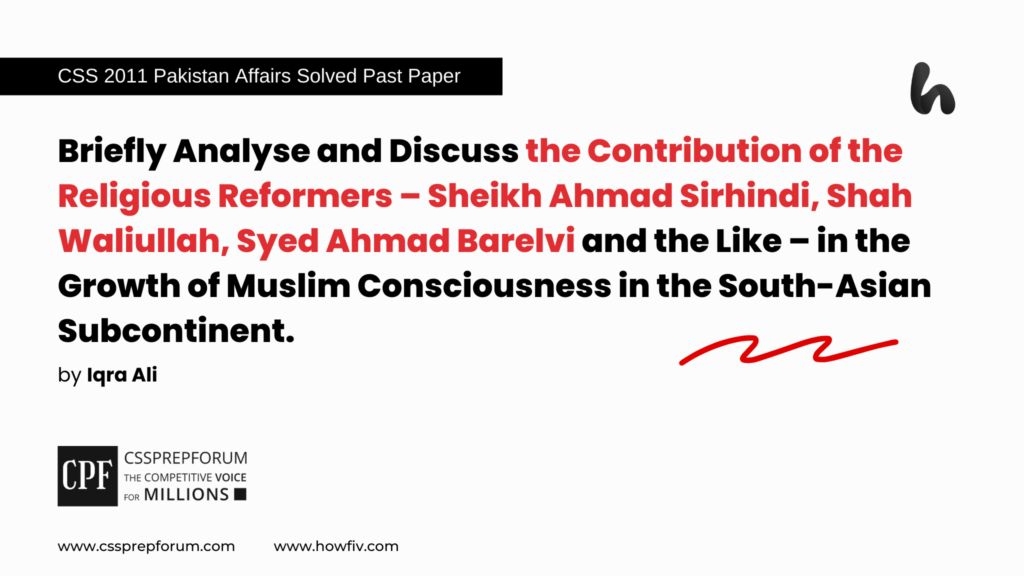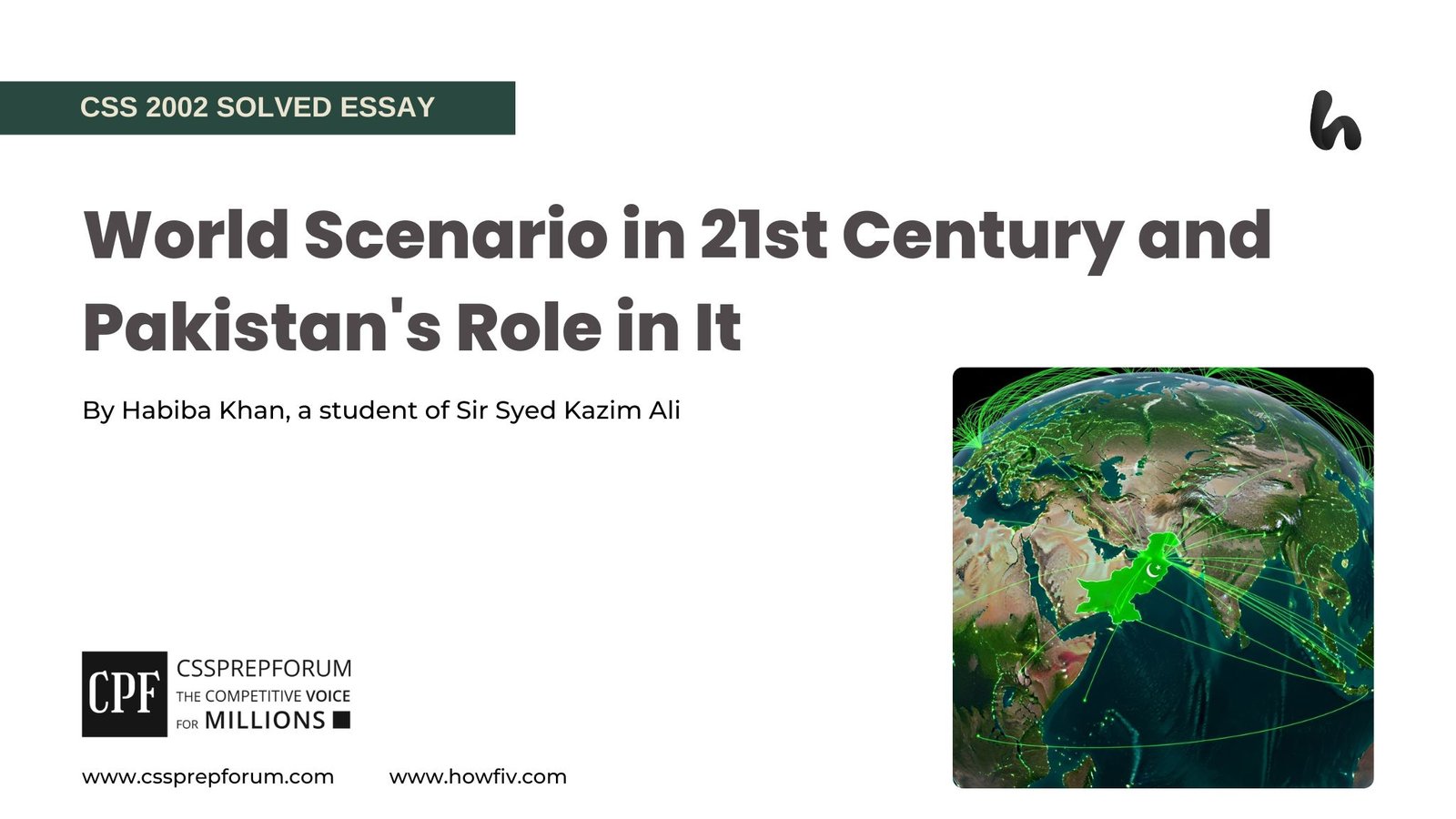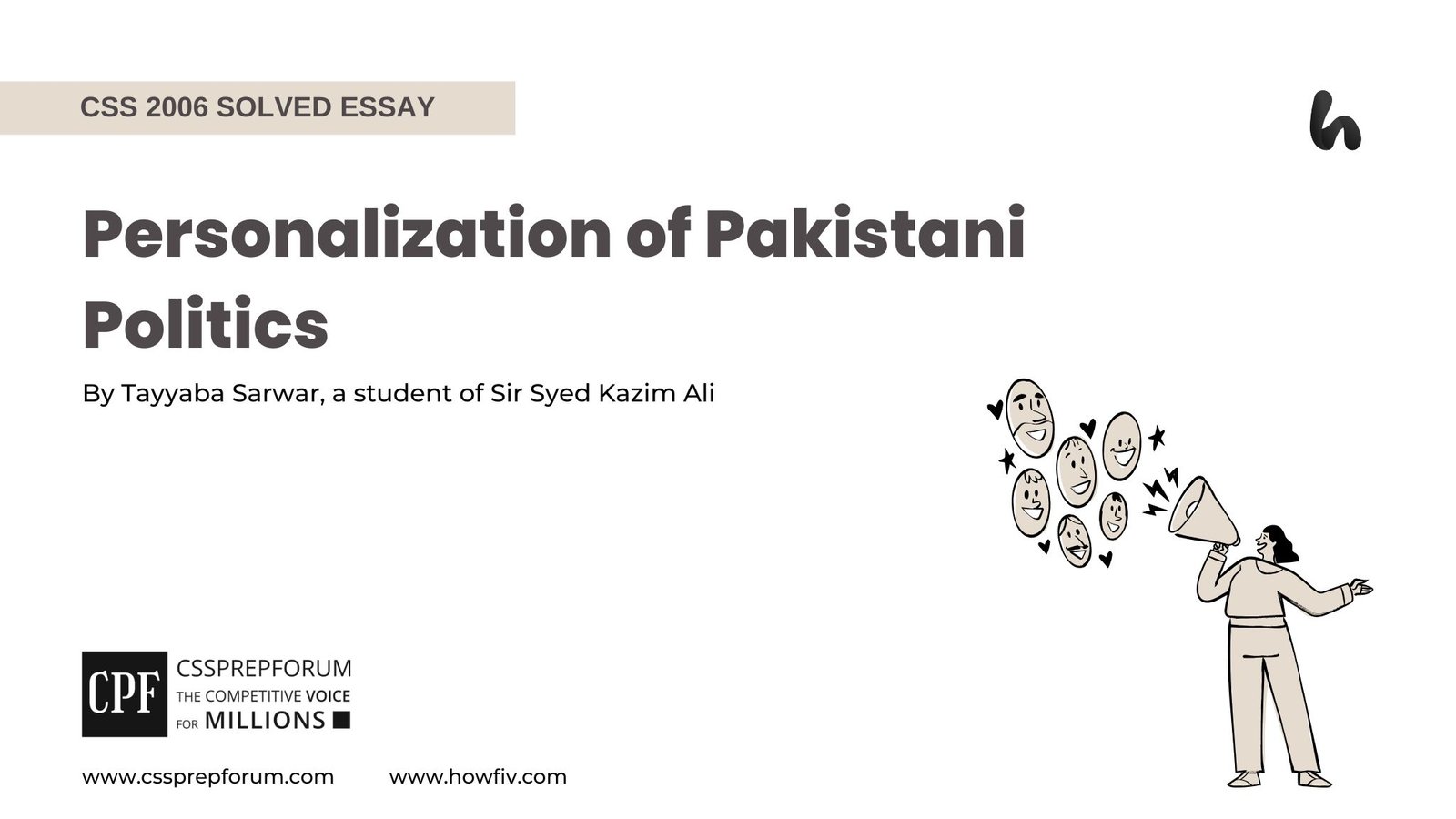CSS 2011 Solved Pakistan Affairs Past Papers | Contribution of the Religious Reformers in the Growth of Muslim Consciousness in the South-Asian Subcontinent
The following question of CSS Pakistan Affairs 2011 is solved by Miss Iqra Ali, the best Pakistan Affairs Coach, on the guided pattern of Sir Syed Kazim Ali, which he taught to his students, scoring the highest marks in compulsory subjects for years. This solved past paper question is uploaded to help aspirants understand how to crack a topic or question, how to write relevantly, what coherence is, and how to include and connect ideas, opinions, and suggestions to score the maximum.

Question Breakdown
In this question, the examiner has asked to discuss and analyze the contribution of the religious reformers – Sheikh Ahmad Sirhindi, Shah Waliullah, Syed Ahmad Barelvi, and the like – in the growth of Muslim consciousness in the South-Asian subcontinent. So, we have to answer considering two demands: first, analyze, and second, discuss. To evaluate, we break down the topic (contribution of religious reformers) into its leading aspects (Revival-socially, politically, and economically). Then, we examine details by critically exploring each part (of their contributions), such as cause, effects, and implications. The analysis needs to be supported by legitimate pieces of evidence. Last, we critically analyze to identify relationships between different parts (movements). To discuss, we need to write the domains (theories) and trace a comparison. Thus, introduce the answer by adding all the leading points. Then, write the main body. In the end, we need to conclude the answer.
Outline
1-Introduction
2-Historical Contextualization of the Socio-Economic Conditions that Sparked the Need for Revival in the Indian Subcontinent
3-Contribution of the Religious Reformers – Sheikh Ahmad Sirhindi, Shah Waliullah, Syed Ahmad Barelvi and the like – in the Growth of Muslim Consciousness in the South-Asian Subcontinent
3.1- Contribution of Sheikh Ahmad Sirhindi to the Growth of Muslim Consciousness in the South-Asian Subcontinent
- ✓ Consciousness Stimulated Intellectual Response against Akbar’s Syncretic Cult, Din-i-Illah (Divine Faith) Awakened the Muslim Society
- ✓ Effects of the Response, the Growth of Muslim Consciousness in the South Asian Subcontinent
3.2- Contribution of Shah Waliullah to the Growth of Muslim Consciousness in the South-Asian Subcontinent
- ✓ Consciousness Stimulated Intellectual Response to the Downfall of Mighty Mughal Realm Awakened the Muslim Society
- ✓ Effects of the Response, the Growth of Muslim Consciousness in the South Asian Subcontinent
3.3- Contribution of Syed Ahmad Barelvi to the Growth of Muslim Consciousness in the South-Asian Subcontinent
- ✓ Consciousness Stimulated Militarily Response to the Downfall of Mighty Mughal Realm and Against the Sikh Domination Awakened the Muslim Society
- ✓ Effects of the Response, the Growth of Muslim Consciousness in the South Asian Subcontinent
4-Striking Similarities and Differences between the Reform Movements
5-Critical Analysis
6-Conclusion

Answer to the Question
Introduction
The growth of Muslim consciousness in the Indian Subcontinent refers to the awareness of the socio-religious cum political conditions, such as the threat to their socio-religious identity and culture or steep socio-political decline followed by a swift response in the form of resistance and revival. The unique role of Muslim Reforms, namely Sheikh Ahmad Sirhindi (1564-1624), Shah Walli Ullah (1703-1762), and Syed Ahmad Shaheed (1786-1831) symbolized a response to the threats encountering socio-religious identity of the Muslims of the Indian Subcontinent in the 16th and 18th century. The following points describe how they contributed to the growth of Muslim consciousness of the Indian Subcontinent. First, Sheikh Ahmad Sirhindi contributed to the growth of Muslim consciousness by intellectually countering the ideological danger imposed by the syncretic cult or Deen-i-Ilahi during the era of Mughal Emperor Jalal-ud-din Muhamad Akbar (1542-1605). As a result, the Muslims became aware that the identity crisis of a nation could lead to its downfall. The awareness persisted, and the notion of the perseverance of the separate identity led to the creation of Pakistan in 1947. Second, Shah Walli Ullah Dehalwi contributed to the growth of the Muslim consciousness of the Indian Subcontinent by intellectually countering the steep decline of the mighty Mughal realm. He consolidated the Muslim society by reverting their socio-political and economic decline. His vision and teachings influence later generations, informing resistance and counter efforts to any threat. For example, Syed Ahmad Shadeed took inspiration from the teachings of Shah Walli Ullah in designing his strategy for the resistance movement. However, the resistance movement demonstrated using the sword, the Jihad (defense), against the Sikh rule in Punjab. Thus, his reformist efforts symbolized resistance against oppression. To conclude, the contribution of these reformers remained monumental in the growth of Muslim consciousness by countering imminent dangers and influencing future generations.
Historical Contextualization of the Socio-Economic Conditions that Sparked the Need for Revival in the Indian Subcontinent
After the establishment of Muslim rule in the Indian subcontinent in the 13th century, one common fact remained prevailed of responding swiftly against threats to Islam. Whenever elements of religious degradation sparked, adulterations made in the teachings of Islam, or foreign forces tried to subjugate the Muslim society, echoes were heard that Islam is in Danger, followed by a swift response, such as the Reform Movement. However, the initiation factors varied for each movement. For example, during the Akbar era (1556-1605), a policy was adopted to secure political alliances, tackling the threat of strong independent local powers, such as Rajputs. Despite being stated as religious toleration, the policy established a syncretic cult, a combination of Islam, Hinduism, and Christianity, titled Deen-i-Illahi or Divine Faith. As a result, it impacted Mughal court decrees and, ultimately, society. Although a group of religious scholars supported Akbar’s decision but echoes heard “Islam is in danger”. This course of events gave birth to an influential figure, a mujadid, Islamic scholar, member of the Naqshbandi Sufi order, and Hnafi scholar named Sheikh Ahmad Sirhindi (1564-1624). His resistance and reform movement helps Muslims preserve their position as a separate socio-cultural and religious identity. Then, in the 18th century, the trajectory of the Mughal Empire started to fall during the reign of Muhammad Shah (1719-48). Shah Walli Ullah (1703-1762), an Islamic Sunni scholar and Sufi reformer, referred to deviation from Islamic norms as a cause of the decline. He made it his life mission to revert the decline. However, his Reform Movement centered on the moral and intellectual awakening of the Muslim Society. Then, the 18th century saw the rise of British power in the Indian subcontinent as part of its colonialist designs. However, in Punjab, the rule of Sikhs was growing at a large pace. Syed Ahmad Shaheed (1786-1831), a scholar, reformer, and military commander, started a war against Sikh domination to liberate Muslims from the rule of Sikhs.
Contribution of the Religious Reformers – Sheikh Ahmad Sirhindi, Shah Waliullah, Syed Ahmad Barelvi and the like – in the Growth of Muslim Consciousness in the South-Asian Subcontinent
The contribution of religious reformers, such as namely Sheikh Ahmad Sirhindi, Shah Walli Ullah, and Syed Ahmad Shaheed, signifies their unique role in bringing renaissance in the socio-economic and political lives of Muslim society of the 15th and 17th centuries. Their Reform Movements symbolized resistance and response to the imminent threat of the decline of the Muslim society of the Indian Subcontinent. The following points describe how the contribution of reformers, namely Sheikh Ahmad Sirhindi, Shah Walli Ullah, and Syed Ahmad Shaheed, led to the growth of Muslim consciousness in the South Asian Subcontinent.
A- Contribution of Sheikh Ahmad Sirhindi to the Growth of Muslim Consciousness in the South-Asian Subcontinent
Consciousness symbolizes the intellectual ability to know, analyze, and respond to circumstances that need attention and response. If not tacked swiftly, it may lead to the downfall of one and the rise of another. On one side, Shiekh Ahmad Sirhindi’s Revival Movement was itself a consciousness-stimulated response to the faltering condition of the Muslim society, and at the order, it helped in the growth of their consciousness.
- ✓ Consciousness Stimulated Intellectual Response against Akbar’s Syncretic Cult, Din-i-Illah (Divine Faith) Awakened the Muslim Society
First, diluting the effect of Akbar’s policy of Din-i-Ilahi, an attempt by Mughal Emperor Akbar to establish a syncretic cult containing the elements of Hinduism, Islam, and Christianity to secure political alliances, and saving the Muslim society from its implications was the leading element of the Sheikh’s silent revolution. Apart from this, consciousness reflects one’s intellectual ability to understand the event and respond intellectually. So, Shiekh’s Movement was an intellectual attempt to bring a renaissance. For example, his letters (Maktubat -i-Imam Rabbani) were a collection of letters written to rulers, scholars, Sufi mystics, and common people (Muslims) who emphasized Tawhid (Concept of one God) while criticizing Din-i-Illahi. It led to the growth of Muslim consciousness because these Maktubat inspired religious and political elites to uphold the directive principles of Shariah (Islamic Source of Law). Then, his Treatise on Prophethood (Risalah-i-Naboowat) was a response against Din-i-Illahi. It helped to awaken Muslim consciousness by refuting ideological challenges aroused by religious syncretism.
- ✓ Effects of the Response, the Growth of Muslim Consciousness in the South Asian Subcontinent
Second, his mission symbolizes a revival in the 15th-century degenerating Muslim society of the South Asian Subcontinent marred by religious adulterations and eclecticism. However, his teachings, intellectual efforts, and the long-term standing of the effects of the reformist movement led to the growth of the Muslim consciousness. His treatise on Monotheism (Risalah-i-Tawhid) emphasized the Oneness of God. For this, one must condemn traditions and practices associated with polytheism. It was evident that these practices were caused by cultural exchanges, so the treatise implicitly described the necessity to realize the distinction between the Muslim and Hindu communities. Thus, his reformist endeavors help establish a firm basis for the two-nation theory. Indubitably, the theory led to the moral, spiritual, intellectual, and political awakening of the Muslims that led to the creation of Pakistan.
B- Contribution of Shah Waliullah to the Growth of Muslim Consciousness in the South-Asian Subcontinent
In the 17th century, circumstances emerged that needed attention and response. If not tacked swiftly, it may lead to the downfall of the Muslim society rise of foreign forces. On one side, Shah Walli Ullah’s Reform Movement was itself a consciousness-stimulated response to the faltering condition of Muslim society, and at the order, it helped in the growth of their consciousness.
- ✓ Consciousness Stimulated Intellectual Response to the Downfall of Mighty Mughal Realm Awakened the Muslim Society
First, he intellectually responds to the downfall of the Muslim’s mighty Mughal realm by making a life mission of reverting it. For the completion of the task, he devised an education-based policy that led to the awakening of the Muslim consciousness. For illustration, he translated the Holy Quran into Persian. As a result, it became easier to understand. His writings, such as Hujjat-ul-Al Baligha and Izalat al-Khafa (The Removal of Ambiguity), help the Muslims understand the reasons for the decline. Further, his Reform Movement, especially the step of purifying the Islamic teachings from the specter of innovations (Biddat), proved monumental in the growth of spiritual, moral, and intellectual awakening of the Muslim society.
- ✓ Effects of the Response, the Growth of Muslim Consciousness in the South Asian Subcontinent
Second, his works reviving the teachings of Islam at every level-social, political, and economic aided Muslims in understanding the reasons for the decline. For example, his attempt to unite Shia and Sunni sects helped Muslims mitigate social stratification and make them able to understand the significance of unity. The pupils of his institution, named Madrassa Rahimiyyah, influenced later generations by highlighting their mentor’s teachings. Further, the Reform Movement strengthened the concept of the two-nation theory. The theory had a monumental role in the creation of Pakistan.
C- Contribution of Syed Ahmad Barelvi to the Growth of Muslim Consciousness in the South-Asian Subcontinent
Following the footprints of Shah Walli Ullah, Syed Ahmad Barelvi (1786–1831), a disciple of Shah Abdul Aziz (the son of Shah Waliullah), led a Jihadi Movement against British Colonialism and Sikh domination in Punjab. The following points explain how he contributed to the growth of Muslim consciousness in the South Asian Subcontinent.
- ✓ Consciousness Stimulated Militarily Response to the Downfall of Mighty Mughal Realm and Against the Sikh Domination Awakened the Muslim Society
First, his defensive movement mobilized people from diverse ethnic backgrounds, such as Bengal, Bihar, and the North-Western Provinces, under one representative, a self-declared Imam, against Sikh domination in Punjab and British colonialism. The movement showcased another aspect i.e., in the case of defense use of the sword against the oppressors. Although he met with utter failure in the Battle of Balakot (1831), his movement inspired Muslims to resist oppression. The anti-colonial sentiments of Syed Ahamd Braveli portrayed a religious side as well by revisiting the non-Muslim role.
- ✓ Effects of the Response, the Growth of Muslim Consciousness in the South Asian Subcontinent
Second, the contribution of Syed Ahmad Brelvi influenced later reformers and political leaders. For illustration, the leaders of the Deoband movement and the All India Muslim League, which sought to safeguard Muslim identity in British India, were influenced by the teachings of Syed Ahmad. Thus, it led to the growth of the Muslim consciousness of the Muslims in the South Asian subcontinent.
Striking Similarities and Differences between the Reform Movements
The following diagram shows similarities between the Reform Movements of Sheikh Ahmad Sirhindi, Shah Waliullah Dehalwi, and Syed Ahmad Barelvi.
| Sheikh Ahmad Sirhindi | Shah Waliullah Dehalwi | Syed Ahmad Barelvi | |
| Emphasis On Islamic Revival | Anti-Approach Toward Un-Islamic Practices, Superstitions, And Cultural Assimilations | Anti-Approach Toward Un-Islamic Practices, Superstitions, And Cultural Assimilations | Anti-Approach Toward Un-Islamic Practices, Superstitions, And Cultural Assimilations |
| Opposition To Non-Islamic Influences | Opposed Akbar’s Syncretic Policies (E.G., Din-I-Ilahi) | Resisted Sectarian Divisions And Un-Islamic Economic Practices | Fought Against The Sikh Rulers And Sought To Establish Islamic Rule |
| Unification Of Muslim Community | Promoted Unity Among Muslims Opposed Ethnic And Regional Divides | Promoted Unity Among Muslims Opposed Ethnic And Regional Divides Attempted To Reconcile Shia-Sunni Difference | Promoted Unity Among Muslims Opposed Ethnic And Regional Divides Attempted To Unite Various Tribes And Regions |
The following diagram shows contrasts between the Reform Movements of Sheikh Ahmad Sirhindi, Shah Waliullah Dehalwi, and Syed Ahmad Barelvi.
| Sheikh Ahmad Sirhindi | Shah Walli Ullah Dehalvi | Syed Ahmad Shaheed | |
| Historical Context | During The Mughal Empire’s Consolidation Era Under Akbar And Jahangir, Resisting The Emperor’s Religious Innovations. | During The Mughal Decline, Addressing Political Fragmentation And Social Disintegration. | During Colonial And Sikh Dominance In Punjab, Leading An Armed Struggle To Restore Islamic Rule |
| Methods Of Reform | Focused On Moral Reform Through Writings (e.g., Maktubat) And Influencing The Mughal Elite. | Focused On Intellectual Reform Through Quranic Translations, Economic Ideas, And Reconciling Sectarianism. | Advocated Military Jihad As A Tool For Islamic Revival. |
| Reach | Mughal Ruling Class And Scholars | General Muslim Populace, Ulema, And Economic Systems | Common People (Muslims) |
| Outcome | Succeeded In Curbing Syncretism (Deen-I-Ilahi) Within The Mughal Court But Limited Impact On Society | Legacy Left Behind For Future Generations With His Scholarly Contributions No Immediate Political Change. | Failed Militarily, Inspired Later Anti-Colonial Struggles As A Symbol Of Resistance |
Critical Analysis
In a critical analysis, the Reform Movements, their aims, and objectives, led by Sheikh Ahmad Sirhindi, Shah Walli-Ullah Dehalwi, and Syed Ahmad Brelvi, were interconnected. The aim of the movements was centered on reviving Islamic norms and led to the growth of Muslim consciousness in South Asia. The development of consciousness was due to the interconnectedness and influence of a movement on later generations. For example, the intellectual works of Shah Waliullah and Sirhindi established the theological groundwork for the jihad movement led by Syed Ahmad Barelvi. In addition, the teachings, writings, works, and ideas of Sheikh Ahmad Sirhindi, Shah Walli-Ullah Dehalwi, and Syed Ahmad Brelvi inspired later movements, such as the Deoband Movement, Aligarh Movement, and Pakistan Movement.
Conclusion
To conclude, the contributions of the Muslim reformers, namely Shiekh Ahmad Sirhindi, Shah Wallu-Ullah, and Syed Ahmad Shaheed, proved monumental in the moral and spiritual awakening and growth of the Muslim consciousness of the Indian Subcontinent. Indubitably, the goals of the reform movements were interconnected, such as Islamic revival, unity, and perseverance of the identity of the Muslim society. However, the reformers contributed by addressing the challenges of their era. Besides, the intellectual contributions of the reformers shaped the future movements by providing the foundation i.e., the Islamic code of conduct and teachings of Holy Quran and Sunnah.
CSS 2011 Solved Pakistan Affairs
| 2-Briefly Analyse and Discuss the Contribution of the Religious Reformers – Sheikh Ahmad Sirhindi, Shah Waliullah, Syed Ahmad Barelvi and the Like – in the Growth of Muslim Consciousness in the South-Asian Subcontinent. | |
| 3-John Plamenatz Defines ‘Nationalism’ as “The Desire to Preserve or Enhance Peoples National or Cultural Identity, When that Identity is Threatened or the Desire to Transform or Even Create it When it is Felt to be Inadequate or Lacking.” In the Light of above Definition, Briefly but Comprehensively Discuss the Respective Roles Played by Sir Syed Ahmad Khan, Allama Iqbal and the Quaid-E-Azam in Strengthening the Muslim Nationalism in India. | |
| 4-Describe the Main Contents and Relative Importance of the Lucknow Pact and Delhi Muslim Proposals and their Respective Impact on the Subsequent Political Developments in India. | |
| 5-Can the Lahore Resolution be termed as the ‘Magna Carta’ of Pakistan? Take a position and support your argument by historical facts, if any. | |
| 6-Give a Critical Appraisal of the Constitutional Crisis/Crises Initiated by the Controversial Actions taken by Governor General Ghulam Muhammad and Endorsed by the Superior Court of Pakistan. Discuss and Analyse its Effects on the Subsequent History of Pakistan. | |
| 7-Federalism Has Been a Continuing Cause of Political Tension in our Country. Will the 18th Amendment Made in the Constitution by the Present Government Solve this Issue Once for All? Take a Position and Support With Your Argument. | |
| 8-Given the Problems that Pakistan is Facing Today, What is Your Vision of Pakistan in the Year 2011? How, in Your Opinion, can be its Internal and External Problems solved? |
CSS Solved Past Papers’ Essays
Looking for the last ten years of CSS and PMS Solved Essays and want to know how Sir Kazim’s students write and score the highest marks in the essays’ papers? Then, click on the CSS Solved Essays to start reading them.
CSS Solved Essays
CSS Solved General Science & Ability Past Papers
Want to read the last ten years’ General Science & Ability Solved Past Papers to learn how to attempt them and to score high? Let’s click on the link below to read them all freely. All past papers have been solved by Pakistan’s top CSS GSA coach having the highest score of their students.
General Science & Ability Solved Past Papers












